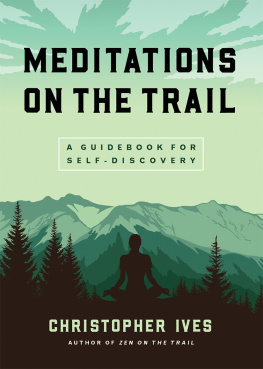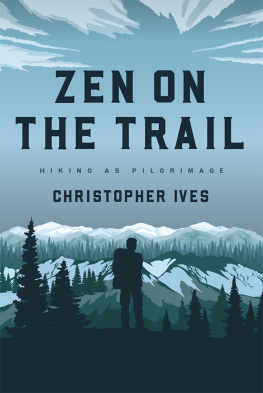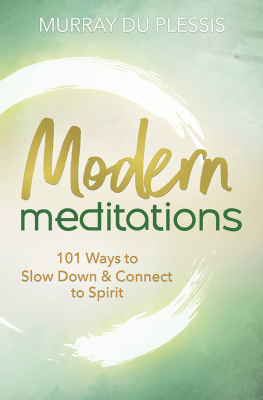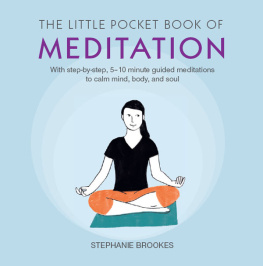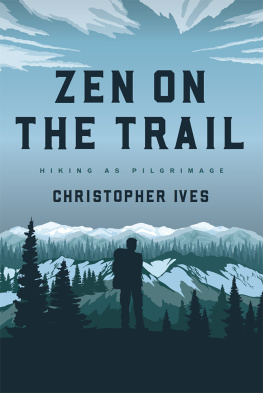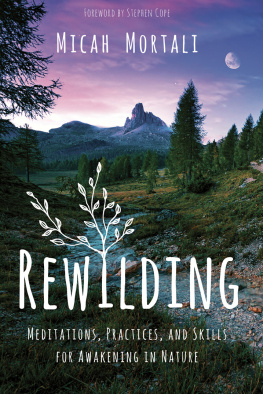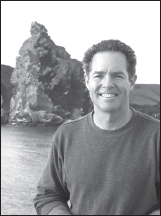Christopher Ives is professor of religious studies at Stonehill College. In his teaching and writing he focuses on ethics in Zen Buddhism and Buddhist approaches to nature and environmental issues. His publications include Zen on the Trail: Hiking as Pilgrimage; Imperial-Way Zen: Ichikawa Hakugens Critique and Lingering Questions for Buddhist Ethics; Zen Awakening and Society; Divine Emptiness and Historical Fullness; a translation (with Abe Masao) of Nishida Kitars An Inquiry into the Good; and a translation (with Tokiwa Gishin) of Hisamatsu Shinichis Critical Sermons of the Zen Tradition.
Son of a scoutmaster, he grew up hiking in the Berkshire Hills of Connecticut and Massachusetts. In college he started backpacking, and this passion has led him into the backcountry across North America and beyond. His outings in nature also include kayaking, bodyboarding, and open-water swimming. In addition to doing these activities, he devotes time to simply being in nature, whether meditating on the trail or sitting out on his back deck taking in the garden, trees, and sunsets.
Appendix: Seated Meditation
If you dont have a meditation technique already, here is how in Zen on the Trail I described doing Zen seated meditation zazen while out on a hike. Whether done outside or indoors in a more formal setting, this practice of seated meditation is foundational to the various practices I set forth above.
Take off your pack. Find a flat rock about eight inches off the ground. Sit on the front edge, cross your legs comfortably, sit up straight. Touch the ground with your hand to fully contact that place, like the Buddha did when he touched the ground in the earth-touching gesture and proclaimed to Mra, The earth is my witness. Feel that spot as your seat, your version of the place where the Buddha sat, his seat of diamond-sharp wisdom.
Put your right hand down on your lap, palm up. Then place your left hand, palm up, on top of the right, with thumb tips touching. In this position your hands will form a round cradle and be encompassed by your arms as a bigger circle, just like how you are contained in and part of the big circle of the universe.
Let your gaze drop down to a spot on the ground about eighteen inches in front of you. Feel yourself sitting there. A pyramid of flesh and bone, polypro and fleece. Aldo Leopold spoke of thinking like a mountain, but on a hike try sitting like a mountain. Settle there. Sit with a broad, firm base. Imagine your butt sinking deep into the earth. Feel your chest as a cliff, your shoulders as spurs slanting off the summit cone. Feel the weathered ridge of your nose, and the summit on the top of your head. Feel the sun and breeze hitting your slopes. Feel the heat rising off your head. Feel your solidity as you sit there. Feel the aches and sweat.
Breathe in the woods around you. And if you can do it without effort, breathe abdominally, from what Japanese monks and martial artists call the hara, your center of gravity in the belly, about an inch below your navel. To inhale, gently push out your belly like a rotund Buddha sculpture in a garden, and bring it back in slowly to send the breath out. Feel your breath come in, bringing fresh air, full of oxygen that is being offered by the larches, cedars, and mountain laurel around you. Feel the air slowly leave through your nostrils. Extend your outbreath slightly until your lungs are empty. Offer up the carbon dioxide to the plants around you.
Then just continue to breathe. Pour yourself into each outbreath. Let sounds enter you, and pass through. Be fully there as a mountain.
After five, ten, or thirty minutes, place your palms together in front of your chest and bow.
When you start to move again, do one thing at a time. Slowly. Extend your legs. Stand up.
Remain still for a minute. Lift your pack and put it on. Latch the hip belt and sternum strap.
When you start walking again, slow your pace 20 percent. Keep it slow, with your breath at ease. And as you continue along the trail and through the day, keep doing just one thing at a time. Give yourself to each step. When wiping your forehead, just wipe your forehead. Just munch the trail mix. Just swig. Dont wobble.
Whether you follow these instructions or pursue another form of meditative contemplation, next time you do your practice outside, start by feeling the weight of your body on the ground. Feel where youre making contact. Feel the pressure on your butt, and possible sensations of warmth or cold. As you settle in your practice, see if you can feel your body pressing into the ground, like a mountain rooted in the ground. Feel yourself rooted, extending down into the firmness below you with no sense of difference between yourself and the earth beneath you. In this way, ground yourself, and feel the calm strength that emerges when we are grounded.
Meditations on the Trail offers a rich array of do-anywhere meditations that will help you explore and deepen your connection to nature, and yourself, in new ways, making the most of your time on the trail.
This small book perfect for throwing in a daypack or a back poc ket as you head out for the trail is filled with practices to take you into the heart of the natural world and uncover your most vibrant self. Youll return home grateful, more aware of interconnection, and maybe just a little wiser.
For walkers of all paces and geographies, this lovely book is a helpful guide for savoring moments on the trail and feeling how deeply related we are to all existence.
STEPHANIE KAZA, author of Conversations with Trees: An Intimate Ecology
Meditations on the Trail is a guidebook to hiking as a spiritual practice that can nurture our capacities for attention, presence, and joy. Ives offers us a sparkling net of Dharma jewels: traditional teachings made accessible through practices that cultivate deep connection with the pulsing matrix of life that envelops and supports us.
WILLIAM EDELGLASS, wilderness guide, director of studies at Barre Center for Buddhist Studies, and associate professor at Emerson College
Join Wisdoms mailing list and find out what to read next!
Receive the latest news and updates from Wisdom, including new releases and special offers.
Click here to sign up.

Bibliography
Bodhi, Bhikkhu, trans. In the Buddhas Words: An Anthology of Discourses from the Pali Canon. Somerville, MA: Wisdom Publications, 2005.
Brown, Edward Espe. Leavening Spirit. Tricycle: The Buddhist Review (Fall 2002): 9091.
Cleary, Thomas, trans. The Book of Serenity. New York: Lindisfarne Press, 1990.
Cousineau, Phil. The Art of Pilgrimage: A Seekers Guide to Making Travel Sacred. San Francisco: Conari Press, 1998.
Dumoulin, Heinrich. Zen Buddhism: A History. Vol. 2, Japan. New York: Macmillan Publishing, 1990.
Hartman, Blanche. The Life That Is Wonderful and Evanescent. In A Beginners Guide to Meditation: Practical Advice and Inspiration from Contemporary Buddhist Teachers, edited by Rod Meade Sperry. Boston: Shambhala Publications, 2014.
Ives, Christopher. Zen on the Trail: Hiking as Pilgrimage. Boston: Wisdom Publications, 2018.
Jensen, Derrick. Listening to the Land: Conversations about Nature, Culture, and Eros. White River Junction, VT: Chelsea Green Publishing Company, 2004.

